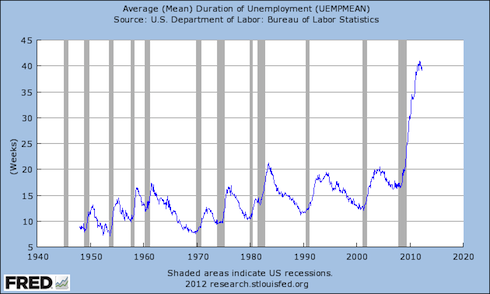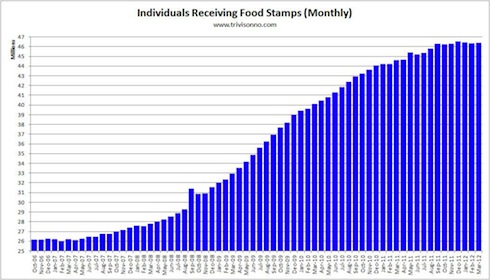Most of my recent analysis has pertained to Europe.
However, on the other side of the pond, the US economy is showing major signs of deterioration. The jobs data, even after the BLS massages it, is awful. Secondly, 1Q12 GDP estimates have been revised lower. We’ve also seen the two consecutive bad Philly Fed surveys, including the fact that the average workweek has shortened for two months now. We’re also seeing a drop in the Empire Manufacturing index.
In addition to this, we’ve seen the following companies cut their forecasts for 2012: Pall (PLL), Nucor (NUE), Ryder Systems (R), Proctor & Gamble (PG), Cardinal Health (CAH), Texas Instruments (TXN), Starbucks (SBUX), Autodesk (ADSK), FedEx (FDX), Jabil Circuit (JBL), Bed, Bath & Beyond (BBBY), and Adobe Systems (ADBE).
Many of these are economic bell-weathers. And anyone in the financial space can tell you, companies only lower their forecasts if things are going to get a lot worse (executives are highly incentivized to maintain positive outlooks for fear of their company’s shares collapsing on downgrades).
In simple terms, we’re getting many signals that the US economy may in fact be slipping into a second recession in the context of a greater DE-pression. Once it’s confirmed that we’re back in recessionary territory (we already are, but it won’t be confirmed by Government officials until after the US Presidential election) then this will mark:
1) The first time in the post-war period that the US has entered a recession in which industrial production failed to exceed its previous peak:
2) The first time the US entered a recession when average unemployment duration was already at record highs:
3) Moreover, the civilian employment-population ratio is at levels not seen since the ’70-’80 (meaning that fewer and fewer Americans are in the workforce).
4) And a recession in which food stamp usage is already near record highs:
To make matters worse, all of this is happening at a time when the US Federal Reserve, which has been the life-support for the US economy (for better or for worse), is finally discovering that its policies and theories don’t actually apply to the real world:
Fed Wrestles With How Best to Bridge U.S. Credit Divide
Fed officials have been frustrated in the past year that low interest rate policies haven’t reached enough Americans to spur stronger growth, the way economics textbooks say low rates should.
By reducing interest rates—the cost of credit—the Fed encourages household spending, business investment and hiring, in addition to reducing the burden of past debts.
But the economy hasn’t been working according to script.
From the Wall Street Journal;This confirms what I’ve been saying for months: the Fed has realized that the consequences of QE (higher cost of living) outweigh the benefits. This is why the Fed only decided to extend its Operation Twist program during its June FOMC: the political climate in the US will not tolerate a large-scale move by the Fed unless a major bank collapses or some kind of systemic risk hits.
This means… that the primary prop underneath the US stock market and financial system (namely Fed intervention) is slowly being removed. What follows will not be pretty and smart investors should be taking steps now to prepare in advance.
- English (UK)
- English (India)
- English (Canada)
- English (Australia)
- English (South Africa)
- English (Philippines)
- English (Nigeria)
- Deutsch
- Español (España)
- Español (México)
- Français
- Italiano
- Nederlands
- Português (Portugal)
- Polski
- Português (Brasil)
- Русский
- Türkçe
- العربية
- Ελληνικά
- Svenska
- Suomi
- עברית
- 日本語
- 한국어
- 简体中文
- 繁體中文
- Bahasa Indonesia
- Bahasa Melayu
- ไทย
- Tiếng Việt
- हिंदी
Signs Point To US Entering Second Recession
Published 07/09/2012, 01:16 AM
Updated 07/09/2023, 06:31 AM
Signs Point To US Entering Second Recession
Latest comments
Loading next article…
Install Our App
Risk Disclosure: Trading in financial instruments and/or cryptocurrencies involves high risks including the risk of losing some, or all, of your investment amount, and may not be suitable for all investors. Prices of cryptocurrencies are extremely volatile and may be affected by external factors such as financial, regulatory or political events. Trading on margin increases the financial risks.
Before deciding to trade in financial instrument or cryptocurrencies you should be fully informed of the risks and costs associated with trading the financial markets, carefully consider your investment objectives, level of experience, and risk appetite, and seek professional advice where needed.
Fusion Media would like to remind you that the data contained in this website is not necessarily real-time nor accurate. The data and prices on the website are not necessarily provided by any market or exchange, but may be provided by market makers, and so prices may not be accurate and may differ from the actual price at any given market, meaning prices are indicative and not appropriate for trading purposes. Fusion Media and any provider of the data contained in this website will not accept liability for any loss or damage as a result of your trading, or your reliance on the information contained within this website.
It is prohibited to use, store, reproduce, display, modify, transmit or distribute the data contained in this website without the explicit prior written permission of Fusion Media and/or the data provider. All intellectual property rights are reserved by the providers and/or the exchange providing the data contained in this website.
Fusion Media may be compensated by the advertisers that appear on the website, based on your interaction with the advertisements or advertisers.
Before deciding to trade in financial instrument or cryptocurrencies you should be fully informed of the risks and costs associated with trading the financial markets, carefully consider your investment objectives, level of experience, and risk appetite, and seek professional advice where needed.
Fusion Media would like to remind you that the data contained in this website is not necessarily real-time nor accurate. The data and prices on the website are not necessarily provided by any market or exchange, but may be provided by market makers, and so prices may not be accurate and may differ from the actual price at any given market, meaning prices are indicative and not appropriate for trading purposes. Fusion Media and any provider of the data contained in this website will not accept liability for any loss or damage as a result of your trading, or your reliance on the information contained within this website.
It is prohibited to use, store, reproduce, display, modify, transmit or distribute the data contained in this website without the explicit prior written permission of Fusion Media and/or the data provider. All intellectual property rights are reserved by the providers and/or the exchange providing the data contained in this website.
Fusion Media may be compensated by the advertisers that appear on the website, based on your interaction with the advertisements or advertisers.
© 2007-2024 - Fusion Media Limited. All Rights Reserved.
